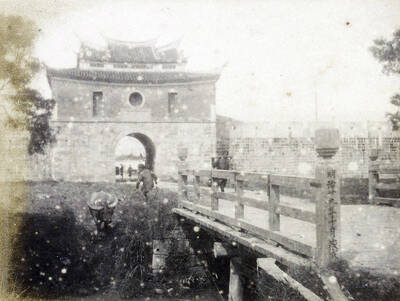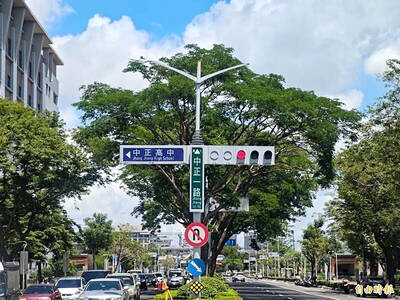Are you on the Internet or the internet?
This debate has been raging for years, but the tide appeared to turn when major US news organizations decided to drop the capitalization of Internet, making it internet.
AP made the lower-case spelling effective June 1, a move quickly followed by The New York Times and Wall Street Journal. In Britain and other locations, media outlets made similar changes over the past few years.

Photo: REUTERS
“We now spell it lowercase, reflecting a growing trend and a change by our official dictionary, Webster’s New World College,” AP said in a statement. “We have also made web lowercase in all instances, and Web page and Web feed one word.”
AFP’s style guide calls for Internet capitalized in English, but lower case in French.
But the shift by US media groups could have an impact on usage.
Joseph Turow, a University of Pennsylvania communications professor who has been pressing for lower-case usage for over a decade, welcomed the change.
“This is part of everyday life and lower-case usage reinforces that idea,” Turow told AFP. “Most people see [the Internet] as a faucet that they turn on to get data.”
English teacher and blogger Mason West wrote that “there was really never a reason to capitalize Internet in the first place, and the writing and editorial world is breathing a collective sigh of relief.”
But the move also stirred passions among those who still view the Internet as a proper noun.
Vint Cerf, often described as the “father of the Internet” for inventing the protocols used online, said the change was a mistake, and that the AP editors “fail to understand history and technology.”
Cerf said in a statement to Politico that there is a difference between the “public” Internet, which he said should be capitalized, and “private internets.”
The latter, he said, use the same protocols “but do NOT connect to the public Internet. By lowercasing you create confusion between the two and that’s a mistake.”
The Internet Society, a nonprofit group created by Cerf and Bob Kahn with a mission to help connect people around the world, also said it was keeping its capital “I.”
“The Internet refers to the globally connected network of networks that enables billions of people and devices around the world to communicate and collaborate,” society spokeswoman Allesandra de Santillana said in an e-mail to AFP.
“Many other networks of networks — internets — use the same technologies but do not connect to the Internet. If we were each using those, we wouldn’t be able to e-mail each other.”
‘THERE IS JUST ONE’
Doc Searls, a journalist and author who has served as a fellow at the Berkman Center for Internet & Society at Harvard University, also defended the capitalization.
“The Internet is like the Universe,” Searls said in a blog post. “There is just one of it. There are no other examples. Formalizing the lower-case ‘internet,’ for whatever reason, dismisses what’s transcendent and singular about the Internet we have: a whole that is more, and other, than a sum of parts.”
Two years earlier, technology analyst Bill Thompson lamented in his BBC column that “those who choose ‘internet’ over ‘Internet’ are as wrong as those who would visit london, meet the queen or go for a boat trip down the river thames.”
The Oxford English Dictionary has kept Internet capitalized while recognizing this has been “passionately debated.”
Oxford’s Katherine Connor Martin said in a blog post that the capitalized form “is slightly more common” at around 54 percent worldwide, even though lower-case internet is more widely used in Britain.
“We are now in the midst of stylistic change with respect to the capitalization of Internet, but the process is proceeding in patchwork fashion and is far from complete,” Martin wrote.
“At Oxford, we will be watching our tracking corpus closely in the coming months, to see if lowercase internet makes new headway against the capitalized form.”

June 9 to June 15 A photo of two men riding trendy high-wheel Penny-Farthing bicycles past a Qing Dynasty gate aptly captures the essence of Taipei in 1897 — a newly colonized city on the cusp of great change. The Japanese began making significant modifications to the cityscape in 1899, tearing down Qing-era structures, widening boulevards and installing Western-style infrastructure and buildings. The photographer, Minosuke Imamura, only spent a year in Taiwan as a cartographer for the governor-general’s office, but he left behind a treasure trove of 130 images showing life at the onset of Japanese rule, spanning July 1897 to

One of the most important gripes that Taiwanese have about the Democratic Progressive Party (DPP) is that it has failed to deliver concretely on higher wages, housing prices and other bread-and-butter issues. The parallel complaint is that the DPP cares only about glamor issues, such as removing markers of Chinese Nationalist Party (KMT) colonialism by renaming them, or what the KMT codes as “de-Sinification.” Once again, as a critical election looms, the DPP is presenting evidence for that charge. The KMT was quick to jump on the recent proposal of the Ministry of the Interior (MOI) to rename roads that symbolize

On the evening of June 1, Control Yuan Secretary-General Lee Chun-yi (李俊俋) apologized and resigned in disgrace. His crime was instructing his driver to use a Control Yuan vehicle to transport his dog to a pet grooming salon. The Control Yuan is the government branch that investigates, audits and impeaches government officials for, among other things, misuse of government funds, so his misuse of a government vehicle was highly inappropriate. If this story were told to anyone living in the golden era of swaggering gangsters, flashy nouveau riche businessmen, and corrupt “black gold” politics of the 1980s and 1990s, they would have laughed.

In an interview posted online by United Daily News (UDN) on May 26, current Chinese Nationalist Party (KMT) Chairman Eric Chu (朱立倫) was asked about Taichung Mayor Lu Shiow-yen (盧秀燕) replacing him as party chair. Though not yet officially running, by the customs of Taiwan politics, Lu has been signalling she is both running for party chair and to be the party’s 2028 presidential candidate. She told an international media outlet that she was considering a run. She also gave a speech in Keelung on national priorities and foreign affairs. For details, see the May 23 edition of this column,